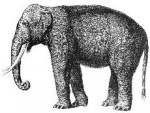
Over 10,000 years ago, mammoths roamed the Earth. Could they possibly roam again? Remains have been found in a construction site in Los Angeles, and are now displayed at the Los Angeles’ George C. Page Museum.
“Zed”, the featured young mammoth, died of a few broken ribs and cancerous lesions on his jaw. The skeletal remains are fairly intact, aside from the shaving of the skull, which was done by a scraper. The construction site, located close to the La Brea tar pits, is now being closely monitored due to its previous discoveries of 3 to 4 million fossilized bones.
Head curator, John Harris, announced publicly the finding of “a whole new treasure trove of fossils” on Feb. 18, describing the discovery as “the most important discovery” for the museum “of the last 90 years.”
A mammoths’ average life span is about 60 years, while “Zed”, died at age 40. Despite the exciting discovery, “Zed’s” actual display will not officially be ready until next year.
Featured on the Stephen Colbert Report on Dec. 4, 2008, author Nicholas Wade proposed the idea of bringing mammoths back to life. Wade, a British-born scientific reporter, editor, and author writes for the Science Times section of The New York Times. Scientists now are noting of the possibilities of bringing mammoths back and have even set a price.
Mammoths, sought after by contemporary humans who first learned to habituate in Siberia 22,000 years ago, died out in both Siberia and North American homelands 10,000 years ago.
“A living mammoth could perhaps be regenerated for as little as $10 million,” states Wade in his article published in The New York Times. “If the genome of an extinct species can be reconstructed, biologists can work out the exact DNA differences with the genome of its nearest living relative.”
The mammoth’s closest living relative is the elephant.
“There are talks on how to modify the DNA in an elephant’s egg so that after each round of changes it would progressively resemble the DNA of a mammoth egg. The final-stage egg could then be brought to term in an elephant mother, and mammoths might once again roam the Siberian steppes.”
But scientists are not just stopping at mammoths. We could see the come back of Neanderthals also, “whose full genome is expected to be recovered shortly…[however],…there would be several ethical issues in modifying modern human DNA to that of another human species.”
Whether or not we see the possibility of walking amongst the mammoths, the overall fact that the idea is plausible stands on firm ground.






